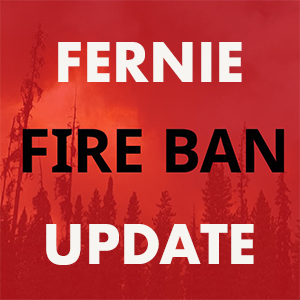I always said that winter was for skiing and summer was for biking—until this season. Some say it’s the low snow pack creating one time only ideal snow biking conditions. A number of Fernie’s summer biking trails are presently riding as well as they do in August. What, can that be true?
A riding buddy called me in October and offered me his Surly Pugsley, the original commercial snow bike, at a great price and I bought it. My thought was that if I used it five times it would be worth it. I am now riding five times a week! Fernie is open for snow biking…

My notice that snow biking was becoming popular was when a slew of complaints from XC skiers came my way. Snow bikers were riding the Elk Valley Nordic Trails where dogs, snowshoers, walkers or bikes are forbidden. And at Fernie Alpine Resort’s (FAR) multi use trails, fast moving and beyond control skate skiers were being compromised by snow bikers riding side by side and not be aware of other users. And at both XC facilities skinny tire bikers were leaving trenches that compromised the skate ski track. That’s a no no.
Shortly after the XC complaints I received a call from FAR management communicating that snow bikers NOT ride the resort at night due to the danger of winch cats and other equipment on the trails. A serious biker accident a couple of years earlier in winter and at night left a young man critically injured. Snow biking at FAR is officially restricted to the multi use trails during day light hours.
At the same time as the above concerns were swirling there were meetings happening discussing snow biking and its official direction. Fernie’s trail stakeholders, the Fernie Trail Alliance and members including the Fernie Trails and Ski Touring Club, Fernie Mountain Bike Club and the Fernie Nordic Society, were establishing guidelines to ensure everyone has fun on the trails. And with these guidelines snow biking in Fernie became official, and here they are:
With the increase in Fat Tire biking this winter, we thought we would suggest some basic trail guidelines for biking on groomed, multi use trails:
1. ONLY ride in areas that allow biking. The Elk Valley Nordic Centre and the Golf Course groomed trails DO NOT allow biking. Island Lake Lodge and the groomed cross country ski trails at Fernie Alpine Resort are multi-use, but at the same time we need to be respectful that the trails are not primarily groomed for biking.
2. YIELD to all other users when riding and ride in control; you’ve got brakes, but others don’t. Also yield to motorized vehicles.
3. WAIT until it firms up; only ride when you are not leaving a groove deeper than one inch (IMBA standards). If there is a firmer part of the trail, ride there. Try to ride to the outer most part of the trail, not down the middle.
4. DO NOT ride on, over or in the classic set tracks.
5. LEAVE room for other users and motorized vehicles to pass (don’t ride side-by-side blocking the full trail).
6. BE POLITE and follow all of the other rules of the trail area, including, but not limited to:
a. Obey all trail access and vehicle signs;
b. Be respectful and be cautious of wildlife;
c. Keep your dogs on leash and under control at all times.
This is a new sport that a lot of people don’t understand yet; we have to be stewards of the trail so as not to have our privileges removed.

The above guidelines are for snow bikers using fat tire bikes and mostly respond to the immediate concerns of Fernie’s XC skiers. Outside of Fernie you will discover that a majority of Nordic Centers allow snow bikes with fat tires. Canmore is the closest high profile facility that allows snow biking however most Canmore locals ride the summer singletrack trails, as we do in Fernie. Similarly in the US most XC resorts allow snow biking in the hope of generating trail revenue from memberships and day passes. Skiing is a declining activity, both XC and Alpine, and all revenue helps the bottom line.
Recently I was having a chat with a couple of Ontario snowmobilers who were complaining about the proliferation of snow bikers riding their trails! Apparently the snow bikers are becoming a nuisance on the groomed snowmobile trails and are not contributing to the grooming cost. I’m certian that Fernie’s snowmobilers aren’t complaining, not yet anyway, as they use the groomed trails only as access and not as their prime riding terrain. However as numbers grow and snow bikers take to their groomed trails there could be issues.
Here are IMBA’s “Fat Bike Best Practices” that address a broader user group including snowmobile trails:
DO NOT RIDE unless you are sure that biking is permitted by the land manager! Always be courteous to other snow travelers.
What are some basic equipment guidelines for a fat bike that will be primarily ridden on snow?
– Wide tires — deep snow coverage may require tires wider than 3.5 inches.
– Tire pressure will often be less than 10 PSI.
– Enough floatation that you can travel over snow without leaving a rut deeper than one inch.
– Sufficient traction that you are able to safely control your bike and ride in a straight line.
Best Practices for Fat Biking on Groomed Nordic Trails
– Only ride at ski areas that allow and encourage biking.
– Yield to all other users when riding. Skiers don’t have brakes but you do!
– Ride on the firmest part of the track.
– Do not ride on or in the classic tracks.
– Leave room for skiers to pass (don’t ride side-by-side with all of your buddies blocking the full trail).
– Allow the track time to set up after grooming and before riding.
– Respect alternate-use days for bikers and skiers.
– Some areas require riding only a purpose-built fat bike, not any old mountain bike. There may be a minimum tire tread width.
– Be an ambassador for the sport: stay polite, educate other riders, discourage bad behavior and follow the rules.
– Help out and get involved by joining your local nordic club.
– Consider donating money for trail grooming.
Best Practices for Riding on Snowmobile Trails
– When riding on snowmobile trails, use a front white blinker and rear red blinker at all times. Wear reflective material on both the front and rear of your body.
– Stay to the far right of the trail and yield to snowmobiles.
– Know and obey the rules of your local land manager. Understand that some trails may be on private property and might not be open to alternative uses.
– Be prepared. Winter travel in the backcountry requires carrying proper gear and dressing properly. Be self-sufficient!
– Use extreme caution when riding at night. Be visible and use the brightest lights you can find.
– Be friendly! Fat bikers are the newest trail users. Be courteous and open to suggestions from snowmobile riders.
– Help out by supporting your local snowmobile club.
– Consider donating to trail grooming and maintenance efforts.
Best Practices for Riding on Natural Terrain and in the Backcountry
In the right conditions, a fat bike can be the ultimate winter backcountry travel tool. Frozen conditions and minimal snow coverage (1-5 inches) means access to areas that are impassible during the warmer months. But just because you can ride somewhere doesn’t mean you should. Be aware and be prepared.
– Do not trespass! Know whether or not you are on private property. Obey ALL land manager rules. Some land parcels are closed to bikes whether you are riding on a trail or not.
– Do not ride through sensitive wildlife habitats. This may be especially important on beaches or in places where animals hibernate. Learn about the area you want to ride in before you ride there.
– Do not disturb wildlife. Many species survive on minimal diets during winter. Stressors or the need to move quickly can deplete their energy stores.
– Learn safe ice travel. Riding on frozen water can be extremely dangerous. Is the ice thick enough to support you? Take ice fishing picks and a length of rope when riding on lakes and rivers.
– Understand changing conditions. New snowfall or warming temperatures can make the return trip much more difficult. Tire tracks can be covered, hard snow can turn to slush, rivers can start to melt. Always know the forecast and be aware of how changing conditions might alter the safe passage of your route.
– Be prepared. Carry provisions in case you have to stay out longer than planned.
– Let people know. Make sure someone else knows where you are going, when you left and when you expect to return.
– Learn to share. Be aware that your tracks might attract other riders. Understand that “your” route might not remain a secret for long.
So, Fernie is open for snow biking and now that you know the guidelines you might be questioning your potential experience and where should you ride. Here are the areas that I recommend:
Fernie Alpine Resort’s multi use trails are a great place for a novice. Groomed to perfection, very modest climbing and very wide make a relaxing ride. There are a few XC skiers that want the trails to themselves however you have equal rights to be there snow biking.

Island Lake Lodge has groomed XC trails, a snowcat road and single track. From the Island Lake parking lot you can access the XC trails, the main snowcat access road, and singletrack including the Lazy Lizard and Rail Trail. The XC trail and snowcat road are both novice and the singletrack is intermediate.


Fernie Mountain Park offers a variety of intermediate and expert singletrack. Be aware that the Elk Valley Nordic Centre connects to the Park and all activities other than XC skiing are forbidden. From the Park, Sherwoody and the Nature trails are relatively intermediate. Gorby, Old Goat, Bem Emmit, Black Forest, Snake Bite, Dem Bones and Stove are very fun and challenging, and recommended for expert riders.

Ridgemont is the most popular area for snow biking and has the widest variety of trails ranging from novice to expert. Ridgemont Road is a great novice ride however is a substantial climb. Feeding off the Road is a variety of more demanding trails including: Cemetery By-Pass, Whats Up Doc, Sidewinder, Deadfall, Eco Terrorist, Kids Stuff, Eric’s and Hessian.

Fernie offers great snow biking and mountain bike trail maps and local lore are available at resident bike shops. If coming to Fernie I strongly recommend bringing your powder skis as we do have a reputation for serious snowfall when it’s NOT forecast.
The trails are managed by the Fernie Trail Alliance and contribution boxes are located on select trails, see the Gorby goat donation box below, or online. If you’re respecting the trails and the builders, be sure to contribute. Hopefully by next year we’ll have a managed snow biking grooming program and for this year, thank you to the snowshoers. Happy snow biking!

























